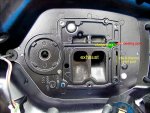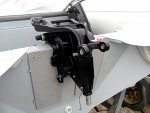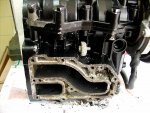Tohatsu 18 HP Restoration.-
Weeks back my 2 strokes 18 developed throttle hesitations issues when opening her past fast idle speed. Having worked continuously for 2 years and clocked 600 run hours decided to tear the powerhead and check its interior condition to latter perform a full preventive maintenance.
The powerhead is just a part of the whole OB, as deslike doing partial preventive maintenances decided to tear the whole OB down in sections and restore each one independently while documenting with data & pics lower leg to powerhead full restoration. Found amazing things while restoring OB to its out of the box condition.
Lower Leg.-
Drained old gear lube and replenished with Amalie API 80-90 multi grade gear oil. Original trim tab which is rather small in size was changed for a larger and wider one that fits the 30 HP model, will protect more efficiently lower leg against corrosion.
If spring pin that holds shift rod onto coupler gets seized due to salt or oxidation, will be a real PITA to remove it, will need to bang pin hard with same or bit less diam tool extractor consequently making coupler to swing and bang sideways against leg.

Dont plan anymore installing original spring pin, for practical purposes, got a SS 3mm diam drill bit, was cut same width as coupler, greased interior of upper coupler and pin hole, inserted lower shift rod along pin, wiped all grease excess around coupler and wrapped tight 3-4 turns of 3M electric tape around coupler and voil?. Nope, water wont unstick tape to coupler. To remove lower leg will only take the time it takes you to remove 4 lower bolts and push the new drill bit out with whatever you like.
If wanting to find water pump housing and adjacent area clean with no salt formations on next lower leg removal, brush small amounts of water grease onto every visible part, include drive shaft length as well.
The liner will always be found with micro round scratches around its circumference due to salt water, particles, debris, sand, you name it while impeller pumps water upwards. To remove those scratches, polished with toothpaste the liner interior circumference to extreme smooth condition. Its done religiously every 300 worked hours along an impeller flip, but thats me, has worked fine for all my OBs. Been doing it for years and this 18 was no exception.

Polishing the liner makes the impeller to last really long while pumping water with excellent pressure. Only possible if impeller vanes are not bottom cracked, are fresh and extremely flexible. NOTE : The (red*) shown on upper liner and lower plate is the molded groove made by upper and lower impeller edges (yellow*) produced when turns at high speed. Nope, the grooves will not lessen impeller pumping pressure. Tohatsu impellers outlasts any other impeller brand by far in durability and proven quality.
Middle Leg.-
Discovered on previous restorations that upper pan water labyrinth feeds water to the internal peeing port. The water connection between labyrinths upper peeing port and outer peeing port is not straight, will not meet. Theres a small hidden water chamber like under rear right hand labyrinth where both internally meet.

Due to use, water, 2 stroke oil, temp a gelatin sludge forms on sludge green area reducing the amount of water going inside upper peeing port and consequently into small water chamber. Poking a wire, cannula up/down peeing port wont do much, as theres no direct connection between both. Have seen cases were complete water pump was changed with no avail whatsoever. Bad music, nobody knew about this hidden water chamber issue. Now you know..
To clear the labyrinth sludge will need to remove thermo and connect a water hose delivering high pressurized water to flush powerhead for some minutes till partial obstruction is cleared and port pees back like a teenager again. A second port (w) to screw flusher adapter was found when disassembling exterior exhaust cover. Its not mentioned on Owners or Service Manuals. Can be used to flush powerhead water paths too same as if flushing through thermo port.

Salt clogs formed inside chamber will limit water outing peeing port, water pump could be blamed for that. In that case insert delivered cannula up port and squirt an overdose of W40 or carb cleaner into chamber, let soak for some minutes to dissolve salt clog. Flush again and check if correct peeing was restored. A Throttle Limiter (TL) was installed, turning limiter CCW will limit the wot operating fully, ideal for kids, women, fearful people when like boating at reduced speeds LOL!!
Swivel Bracket Assy.-

Was completely disassembled, Steering shaft, swivel bracket & bushings, all rotating parts were cleaned with acrylic thinner, greased, assembled back and properly adjusted including throttle grip steering load.

To properly grease swivel bracket and throttle grip pinion & collar without the aide of a grease gun which dont have nor plan buying, had to use my imagination and develop a grease syringe, its a 5 CC syringe filled with OMC grease and fitted with different top fittings for diverse small grease jobs.

Made the work as intended, dont need to add a ton of grease till over filled, the right amount will suffice. Can re grease anytime when needed.
Reverse Lock.-


Tilt Stopper and adjacent movable parts were disassembled, cleaned, greased and assembled back for a smooth trouble free pivoting operation when raising lower leg for shallow water operation or when fully tilting OB up.
Upper Pan Cover.-
Base gasket was found with half of it missing, was burned out by exhaust. Should be replaced at each 300 worked hours, if not exhaust noise and fumes will be increased along water draining on pan.

All sliding and rotating parts as shift lever, throttle grip & mechanism, advancer arm were disassembled, cleaned, greased and assembled back for a smooth throttle operation. If OB has excessive side play when bouncing lower leg back and forth, change both steering white bushings, grease them well before are placed inside of swivel bracket body.

Sometimes due to alt formations, dried grease throttle grip tuns hard to rotate. To smooth it out, remove steering handle. disconnect throttle shaft from rod joint and pull backwards. Pull pinion and file it down gently to smooth it out, same with internal bushing, fill middle groove with water grease and slide pinion back in, connect back what was previously removed.
Theres a hidden bolt side to shift lever stopper plate, is bolt becomes loose with use will have unwanted starter lock issues. Adjust this bolt as its not delivered that tight before that happens.

Powerhead.-

Crankcase & cylinder head water paths were found clean, slightly salted and oxidized, with no internal erosion whatsoever.

Internal cylinder head and pistons were found slightly carbonized due to high quality 2 strokes oil, premium fuels, engine tuner use along boating usually at ? throttle range which gives a excellent fuel consumption rate.
Inner Exhaust Cover & Chamber.-

Was found pretty carbonized with thick carbon crust layer. Was decarboned to perfection. Managed to restore both thick inner & outer cover gaskets. All internal water paths were cleaned, a new internal anode was installed. Previous was found extreme salted and eroded.

A fast way to decarbonise cylinder head is to dip it in a soda caustic solution bath for one hour and brush it off with a soft metal brush to immaculate clean cond. Repeat procedure if still needed.

Internal cylinder and piston heads were hand polished with green pad and toothpaste to a perfect smooth condition, with new plugs and new head gasket for opt combustion, will collect less carbon build up than when remaining porous as factory delivered.

Tohatsu recommends to retorque cylinder head, exhaust cover and base gasket soon after break in period ends, heat compresses head gasket, what was factory torqued will no longer remain same, thats why a first retorque with torque wrench is mandatory. Its advised to retorque all mentioned gaskets after every 100 worked hours and a head gasket, base gasket change every 300 hours for OB to work with trouble free operation throughout the whole throttle range. If its not done gaskets will be screwed much faster.
Continues on page 9..












































